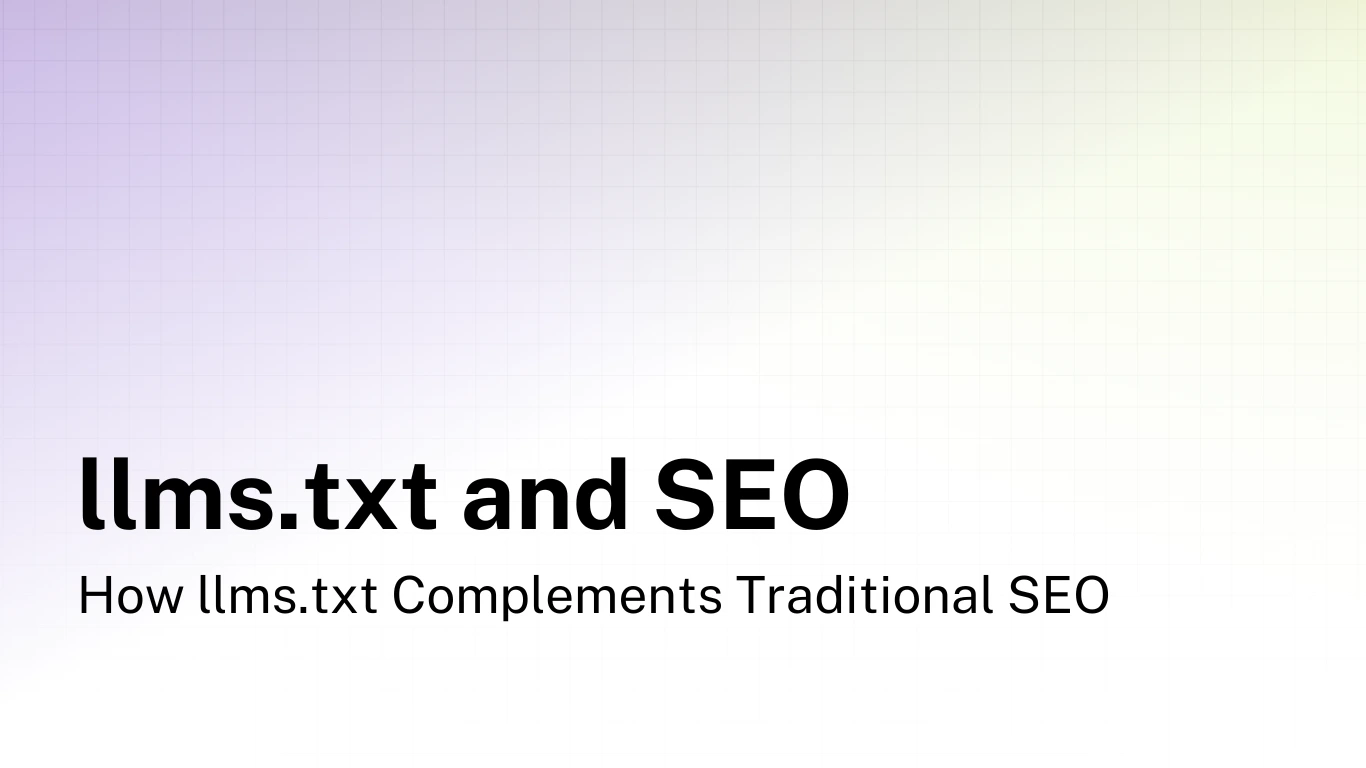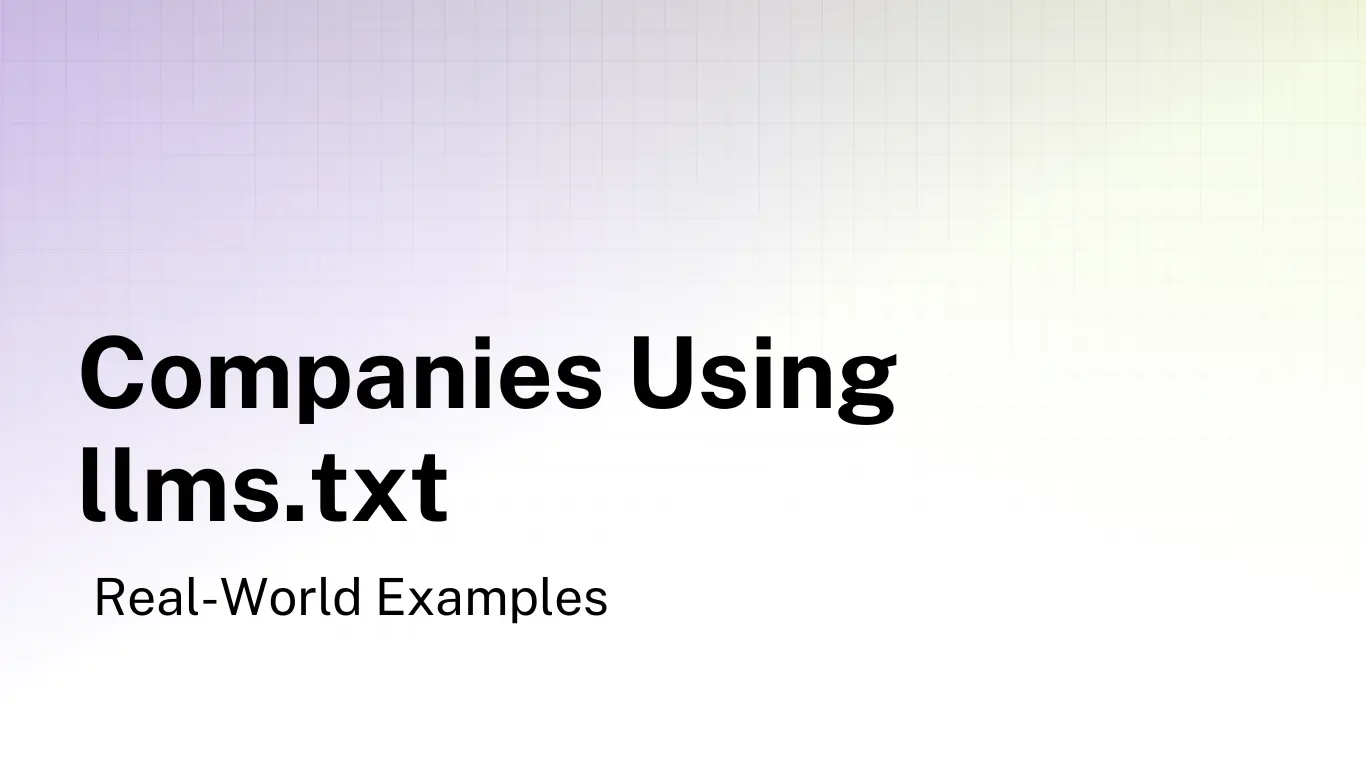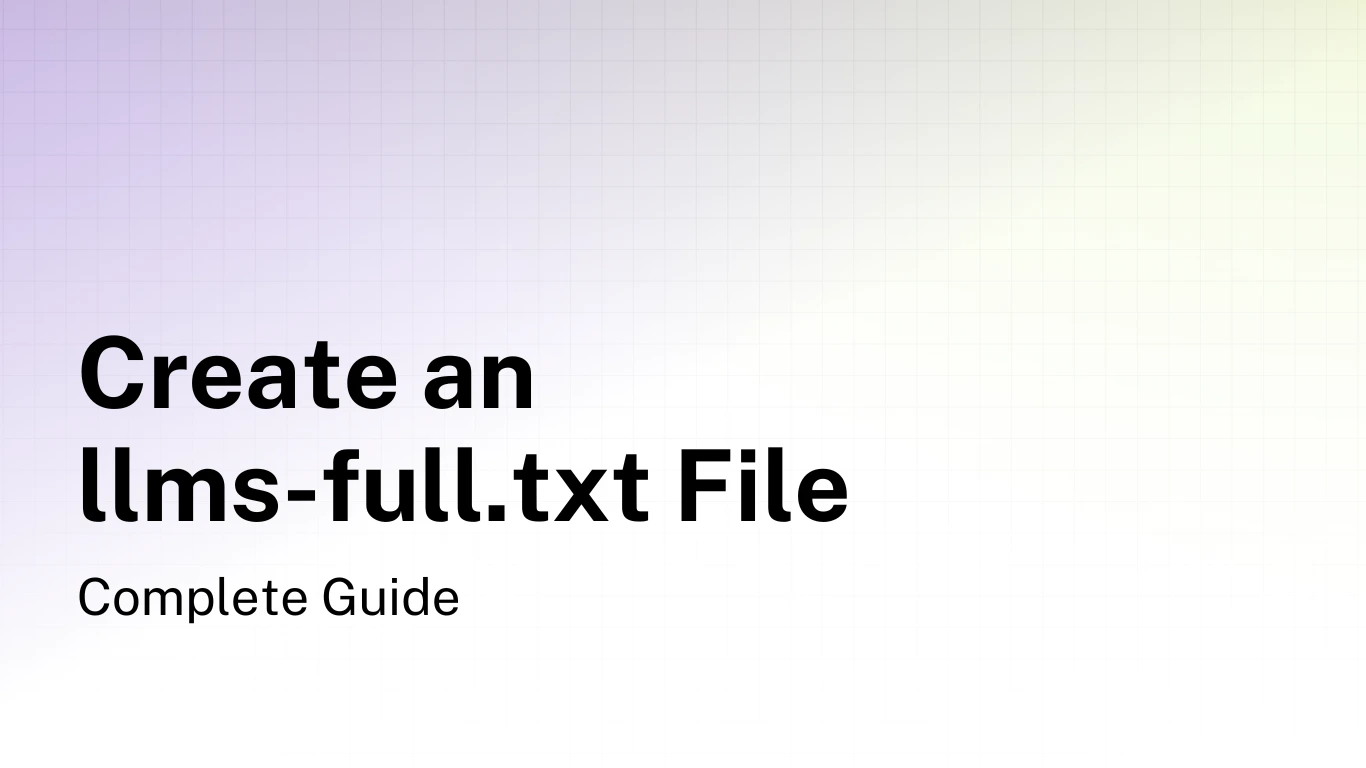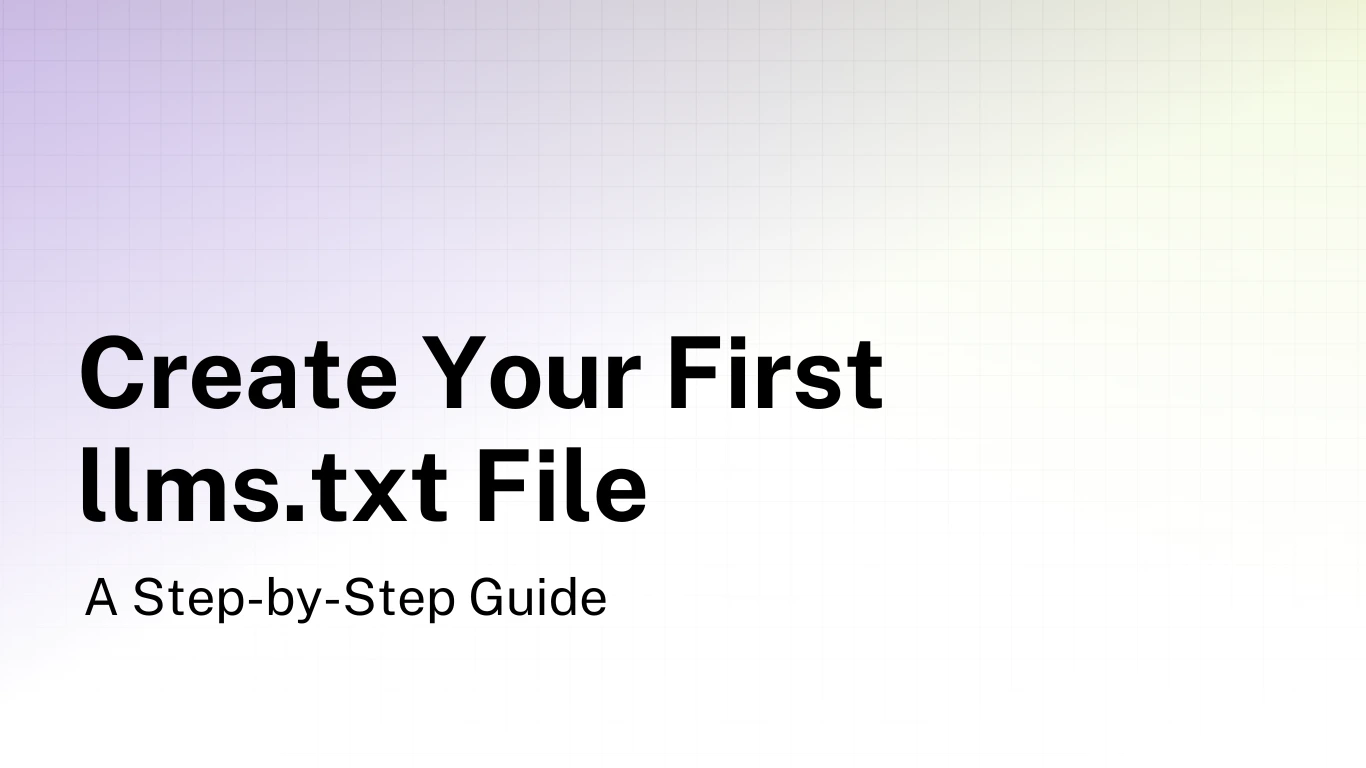SEO in the Age of AI: How llms.txt Complements Traditional SEO

For over two decades, search engine optimization (SEO) has been the cornerstone of online visibility. But today, as AI systems increasingly mediate content discovery, a new paradigm is emerging.
The introduction of llms.txt represents not a replacement for traditional SEO, but rather a powerful complement to existing strategies.
In this article, we'll explore how traditional SEO and AI-friendly llms.txt work together, why you need both, and how to implement a strategy that optimizes your content for both search engines and large language models.
Different Discovery Systems: Search Engines vs. LLMs
Search engines and large language models (LLMs) discover and process your content in fundamentally different ways, creating distinct optimization challenges.
How Search Engines Process Content
Traditional search engines like Google follow a systematic process.
- Crawling: Bots systematically navigate the web by following links, discovering content.
- Indexing: Content is processed, analyzed, and stored in massive databases.
- Ranking: When users search, algorithms determine which content best answers their query.
- Presentation: Results are displayed as a list of links with snippets, requiring users to click through to read the full content.
This approach has shaped SEO practices for decades, focusing on keywords, metadata, structured data, backlinks, and technical performance.
How LLMs Process Content
LLMs operate with a different paradigm.
- Context Building: LLMs need to assemble relevant context before generating responses.
- Comprehension: They must understand entire documents rather than just matching keywords.
- Content Generation: Instead of providing links, LLMs generate answers directly using the content they access.
- Context Window Limitations: They have finite capacity for processing information at once.
These differences create unique challenges that traditional SEO practices don't fully address.
Traditional SEO: Still Essential in 2025
Despite the rise of AI, traditional SEO remains vital for online visibility. Its core components include the following.
On-Page and Technical SEO
The foundation of SEO includes keyword optimization, meta tags, heading structure, and quality content. Technical aspects like site speed, mobile optimization, schema markup, XML sitemaps, and robots.txt directives help make sure your site is crawler-friendly and properly indexed.
HTML pages optimized for search engines help users find your content through direct searches. This remains critical since most users still begin their information journey with a search query.
The Limitations for LLMs
However, traditional SEO has significant limitations when it comes to LLMs.
The HTML pages that work well for search engines—with their navigation elements, ads, JavaScript functionality, and complex layouts—often create inefficiencies for LLMs. Context window constraints prevent LLMs from processing entire websites at once, while keyword-optimized content doesn't always provide the full understanding LLMs need.
Additionally, SEO often encourages verbose content to cover many keyword variations, while LLMs benefit from more concise, curated information.
How llms.txt Bridges the Gap
The llms.txt standard was specifically designed to address the unique needs of large language models while working alongside your existing SEO strategy.
Core Features of llms.txt
Unlike robots.txt or sitemap.xml, llms.txt serves as a curated guide to your most important content in a format optimized for AI systems:
- Curated navigation: Provides a structured overview of the most relevant content
- Clean, structured format: Uses Markdown to present content that's easy for both humans and LLMs to read
- Context optimization: The "Optional" section helps LLMs make better use of limited context windows
- Direct access to content: The .md extensions provide clean, markup-free versions that LLMs can process efficiently
- Publisher-directed focus: Lets you explicitly tell LLMs what content matters most
Generate llms.txt files for your website
Use our free generator to make your sites AI-friendly, in seconds.
Generate nowThe Power of Complementary Strategies
Far from competing approaches, traditional SEO and llms.txt implementation work together to maximize your content's visibility across multiple discovery channels.
Different Paths to the Same Content
SEO makes your content discoverable through direct search, while llms.txt optimization makes it accessible to users engaging with AI assistants. The same core content can serve both channels, just with different formatting and presentation.
Both approaches value clear structure, quality information, and thoughtful organization—they just optimize for different delivery mechanisms. Implementing both strategies creates a future-proof approach to content discovery as user behavior continues to evolve.
Dual Coverage Benefits
This dual approach provides several key advantages.
- Broader audience reach: You connect with users regardless of their preferred discovery method
- Content consistency: Your brand message stays consistent across all channels
- Future-proofing: Your visibility remains strong as discovery habits evolve
- Enhanced user experience: Both direct searchers and AI users receive optimized information
Implementation Strategy: Combining SEO and llms.txt
Creating an effective dual optimization strategy isn't as complex as it might seem. Here's a practical approach:
1. Start with Quality Content
High-quality, valuable content remains the foundation for both approaches. Focus first on creating genuinely valuable information that serves your audience's needs. No optimization strategy can compensate for poor content.
2. Implement Traditional SEO
Continue optimizing your HTML pages with proven SEO techniques.
- Keyword research and strategic integration
- Meta tags and descriptions
- Schema markup for enhanced SERP features
- Performance optimization for better user experience
- Quality backlinks from relevant sources
3. Build Your llms.txt Infrastructure
Alongside your SEO efforts, implement the llms.txt standard.
- Create a well-structured llms.txt file in your root directory
- Generate clean Markdown versions of key pages with .md extensions
- Create a complete llms-full.txt file containing complete documentation
4. Maintain and Monitor
Keep your dual strategy effective with ongoing maintenance.
- Make sure information consistency across both formats
- Set up automated systems to keep everything in sync
- Monitor performance through traditional search metrics and AI assistant usage
- Regularly test how LLMs interpret your content
Real-World Example: GreenGear Outdoor
Let's see how a hypothetical e-commerce company implements this dual strategy.
Traditional SEO Implementation
GreenGear Outdoor optimizes its site for traditional search with:
- HTML pages targeting keywords like "sustainable hiking gear"
- Product schema markup for enhanced search results
- Image optimization with alt tags and compression
- Site speed improvements for better mobile experience
- Blog content addressing long-tail keywords
- Backlinks from outdoor and environmental sites
llms.txt Implementation
Simultaneously, GreenGear creates an llms.txt file.
# GreenGear Outdoor
> GreenGear Outdoor provides sustainable, eco-friendly hiking and camping equipment for environmentally conscious adventurers.
Founded in 2018, GreenGear Outdoor is committed to sustainable manufacturing practices and zero-waste packaging for all products.
## Products
- [Hiking Equipment](https://greengear.com/products/hiking.md): Sustainable backpacks, trekking poles, and accessories made from recycled materials.
- [Camping Gear](https://greengear.com/products/camping.md): Tents, sleeping bags, and cooking equipment with minimal environmental impact.
## Sustainability
- [Our Manufacturing Process](https://greengear.com/sustainability/manufacturing.md): How we create durable products while minimizing ecological footprint.
- [Materials Guide](https://greengear.com/sustainability/materials.md): Detailed information about the recycled and sustainable materials we use.
## Customer Support
- [Product Care & Maintenance](https://greengear.com/support/care.md): Instructions for maintaining and repairing your GreenGear products.
- [Returns & Warranty](https://greengear.com/support/warranty.md): Our lifetime repair guarantee and return policies.
## Optional
- [Company History](https://greengear.com/about/history.md): The story of GreenGear's founding and evolution.
- [Team Bios](https://greengear.com/about/team.md): Meet the passionate outdoor enthusiasts behind our products.
This creates multiple discovery paths for potential customers while maintaining consistent brand messaging.
Future Trends in Search and AI Discovery
The relationship between traditional search and AI-mediated discovery continues to evolve rapidly. At the moment, we can see a few key trends that are emerging.
Converging Technologies
Major search engines are already incorporating AI into their ranking algorithms and results display.
Google's Search Generative Experience and similar initiatives blur the line between traditional search and AI-generated responses.
Evolving Data Formats
Structured data formats will likely evolve to better serve both traditional search and AI systems, potentially converging with aspects of the llms.txt approach.
New Measurement Tools
New analytics tools will emerge to help content creators understand how their content performs specifically in AI systems and LLM-based applications.
Workflow Automation
Automated optimization tools that maintain content for both search engines and LLMs will become mainstream, reducing the manual work involved in dual optimization.
Best Practices for Effective Implementation
To maximize the effectiveness of your dual optimization strategy, follow these best practices.
Focus on User Value First
Always prioritize providing genuine value to your audience, regardless of how they discover your content. Both search engines and LLMs ultimately favor content that serves user needs.
Maintain Content Consistency
Make sure your messaging and information remain consistent across both SEO-optimized and LLM-optimized content. Conflicting information damages credibility.
Streamline Your Workflow
When updating content, make it a habit to update both your HTML pages and corresponding Markdown versions. Consider setting up automation to maintain parity.
Test Regularly
Regularly test how LLMs interpret your content by asking questions about your products or services to popular AI assistants. This reveals any gaps in your optimization.
Embrace Structure and Clarity
Clear, well-structured content benefits both search engines and LLMs. Focus on organization, readability, and logical information flow.
Conclusion
The emergence of llms.txt doesn't signal the end of traditional SEO—far from it. Instead, it represents an opportunity to expand your content's reach across multiple discovery channels. By implementing both approaches, your content is optimized for both direct search and AI-mediated discovery.
As AI continues to transform how users find and interact with information online, the most successful content strategies will embrace both paradigms. The future of digital visibility isn't SEO or llms.txt—it's SEO and llms.txt working together to help your content reach your audience, however they choose to find it.
By starting your dual optimization strategy today, you'll be well-positioned to maintain and grow your online visibility as the digital landscape continues to evolve.






